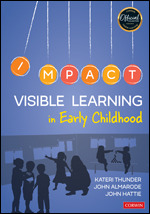Visible Learning in Early Childhood
- Kateri Thunder
- John Almarode - James Madison University, USA
- John Hattie - The University of Melbourne, Australia
Make learning visible in the early years
Early childhood is a uniquely sensitive time, when young learners are rapidly developing across multiple domains, including language and literacy, mathematics, and motor skills. Knowing which teaching strategies work best and when can have a significant impact on a child’s development and future success.
Visible Learning in Early Childhood investigates the critical years between ages 3 and 6 and, backed by evidence from the Visible Learning® research, explores seven core strategies for learning success: working together as evaluators, setting high expectations, measuring learning with explicit success criteria, establishing developmentally appropriate levels of learning, viewing mistakes as opportunities, continually seeking feedback, and balancing surface, deep, and transfer learning. The authors unpack the symbiotic relationship between these seven tenets through
- Authentic examples of diverse learners and settings
- Voices of master teachers from the US, UK, and Australia
- Multiple assessment and differentiation strategies
- Multidisciplinary approaches depicting mathematics, literacy, art and music, social-emotional learning, and more
Using the Visible Learning research, teachers partner with children to encourage high expectations, developmentally appropriate practices, the right level of challenge, and a focus on explicit success criteria. Get started today and watch your young learners thrive!
Free resources
Tips and Consideration for Playful Learning
As you intentionally plan your language for creating rich verbal inquiry in playful learning, consider these guidelines and tips from Visible Learning in Early Childhood.
Chapter 5: Visible Learning and Understanding the World in Early Childhood
In Chapter 5 from Visible Learning in Early Childhood, the authors focus on the following questions: What works best in early childhood learning as children learn about their world? How do we activate learning in our young learners in ways that help them better understand the world?
"In their fascinating new book, Visible Learning in Early Childhood, Kateri Thunder, John Almarode, and John Hattie examine the studies that show which teaching practices have made the greatest impact on young learners in their early childhood classrooms. As readers, we gain insight into how these evidence-based practices are embedded in classroom instruction by learning from five early childhood educators who take us along their teaching journeys. This book is a beautiful, accessible blend of research and practice–where the research sets the foundation for teacher decision-making and comes alive in teachers’ enacted practices with young children."
"Visible Learning in Early Childhood provides an articulate and accessible argument for implementing evidence-based practices that will have the greatest effects on children’s learning. Grounded in seven core ideas from the research, the authors answer the question: What works best when? The authors unpack the research and then connect it to practical applications as they describe the research in action inside early childhood classrooms. This book is a must-read for early childhood educators, administrators, and professors."
A very comprehensive and accessible student resource.
